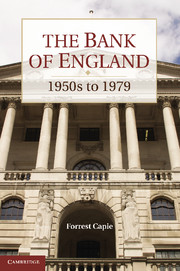Book contents
- Frontmatter
- Contents
- List of Illustrations
- List of Figures
- List of Tables
- Foreword by Mervyn King
- Preface
- Acknowledgements
- Abbreviations and Acronyms
- 1 Introduction and Overview
- 2 The Bank in the 1950s
- 3 The Monetary Setting and the Bank
- 4 The Bank's External Responsibilities to 1964
- 5 From Crisis to ‘Crucifixion’
- 6 Domestic Monetary Policy after Radcliffe
- 7 Other Activities and Performance
- 8 Sterling from Devaluation to Smithsonian
- 9 The Road to Competition and Credit Control
- 10 Competition and Credit Control
- 11 The Secondary Banking Crisis
- 12 Banking Supervision
- 13 Monetary Targets and Monetary Control
- 14 The Bank and Sterling in the 1970s
- 15 The Bank's Freedom to Operate
- 16 Epilogue
- Bibliography
- Index
- Titles in the series
Foreword by Mervyn King
Published online by Cambridge University Press: 05 July 2011
- Frontmatter
- Contents
- List of Illustrations
- List of Figures
- List of Tables
- Foreword by Mervyn King
- Preface
- Acknowledgements
- Abbreviations and Acronyms
- 1 Introduction and Overview
- 2 The Bank in the 1950s
- 3 The Monetary Setting and the Bank
- 4 The Bank's External Responsibilities to 1964
- 5 From Crisis to ‘Crucifixion’
- 6 Domestic Monetary Policy after Radcliffe
- 7 Other Activities and Performance
- 8 Sterling from Devaluation to Smithsonian
- 9 The Road to Competition and Credit Control
- 10 Competition and Credit Control
- 11 The Secondary Banking Crisis
- 12 Banking Supervision
- 13 Monetary Targets and Monetary Control
- 14 The Bank and Sterling in the 1970s
- 15 The Bank's Freedom to Operate
- 16 Epilogue
- Bibliography
- Index
- Titles in the series
Summary
This volume is the latest in a series of ‘official’ histories of the Bank: it joins Clapham (1694–1914), Sayers (1891–1944), and Fforde (1941–58) and brings the story up to the end of 1979, which, for all sorts of reasons, proved a watershed for the Bank, as it did for the nation. The works in this series are official only in the sense that the Bank has sponsored their preparation and publication, providing access and research support: the selection of material and its presentation are the author's responsibility, and the Bank does not interfere. The benefits of this approach are, I believe, especially evident in this volume, and I am immensely grateful to Forrest Capie for providing such a thorough, perceptive, and (improbably) entertaining account.
The period covered is one of the least happy in our economic history, covering the series of crises that preceded the devaluation of 1967, the secondary banking crisis of 1973–74, and the great inflation of the 1970s. Neither the instruments of policy nor the policies themselves seemed capable of addressing the seemingly irreversible decline in our fortunes.
However, the Bank is at its best in adversity, and whatever private doubts might have been harboured, heroic deeds were done. Governor Cromer famously assembled $3,000 million of central bank credits to support sterling over the telephone on a single morning in 1964. Roy Bridge, the Head of Foreign Exchange, set and sprang traps for the sterling bears.
- Type
- Chapter
- Information
- The Bank of England1950s to 1979, pp. xvii - xviiiPublisher: Cambridge University PressPrint publication year: 2010
- 2
- Cited by



